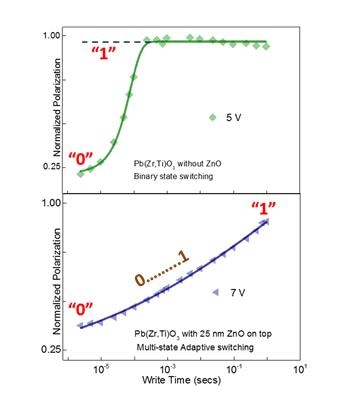Jul 11 2016
The human brain does not function like a standard computer memory storing just ones and zeroes, but has a larger difference in memory states, and can analyze faster using less energy.
 two memory states of PZT without ZnO versus multiple states when 25 nanometer of ZnO is applied
two memory states of PZT without ZnO versus multiple states when 25 nanometer of ZnO is applied
Now, researchers from the MESA+ Institute for Nanotechnology at the University of Twente (The Netherlands) have created a ferro-electric material having a memory function like neurons and synapses in the brain, causing multistate memory. Their study results will be published this week in the Advanced Functional Materials journal.
The lead-zirconium-titanate (PZT), a sandwich of materials with numerous appealing properties, is the newly developed material and it could be the essential element for ‘brain-inspired computing’. Ferro-electric is one of the materials with which users can switch to a desired state, and it continues to be stable even after the electric field is no longer present. This is known as polarization and it leads to a rapid, non-volatile memory function. For instance, a computer integrated with processor chips could be designed to start much faster. The researchers from UT attached a 25 nm thin layer of zinc oxide with the PZT, and they found that changing from one state to another not only occurs from zero to one and vice versa. It is possible to manipulate small regions within the crystal: Would they be polarized or not?
There are essentially two memory states in a PZT layer with no zinc oxide (ZnO), and each state in between is achievable by adding a ZnO nano layer.
Multistate
The researchers say that by utilizing variable writing times in smaller regions, many states can be stored any place between zero and one, and this looks like the way neurons and synapses ‘weigh’ signals in the brain. Combined with transistors, multistate memories could radically enhance the pattern recognition speed, for instance, the human brain carries out this type of tasks with only a portion of the energy a computer system requires. Examining the graph, the writing times appear to be longer than today’s processor speeds, however, it is possible to make several memories in parallel. The brain’s operation has already been imitated in software such as neurale networks, however, a standard digital hardware is still a problem in that case. The newly designed material is an initial step towards achieving electronic hardware having a brain-like memory. The next step would be identifying solutions for integrating PZT with semiconductors, or creating novel types of semiconductors for this.
This study was performed in the Inorganic Materials Science group, of UT’s MESA+ Institute for Nanotechnology. Other appealing properties of PZT, similar to piezo-electrical behavior, have also been found by this group, such as the piezo-electrical material expanding with electric voltage and by pressing it, voltage can be generated.